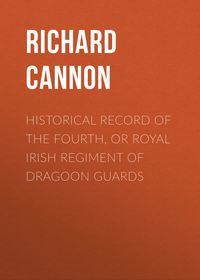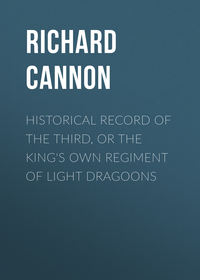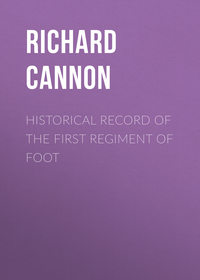 полная версия
полная версияHistorical Record of the Third or Prince of Wales' Regiment of Dragoon Guards: From Its Formation in 1685 to 1838
The infantry having advanced in the face of a storm of fire from the enemy's batteries, and commenced the assault, were forced to give way, when the French and Bavarians, issuing from their works, charged the broken ranks, but were driven back. The attack was renewed with similar results. The infantry, reduced in numbers and exhausted by repeated struggles, were giving way, when Lieutenant-General Lumley led the English horse to their aid, and prevented a repulse. The infantry renewed the attack, and eventually the enemy was driven from the works. At this moment the Fourth Horse and other cavalry gallopping forward, by a furious charge completed the victory.22 The broken battalions and squadrons fled in confusion, pursued by the victorious British and German horsemen, who intercepted the fugitives on every side, and the carnage which followed was dreadful. Many of the French and Bavarians were intercepted on the way to Donawerth, others hurrying to the bridge of boats broke it down by their weight and perished in the river. Their commander, Count D'Arco, escaped with difficulty. Sixteen pieces of cannon, thirteen colours, all the tents, equipages, and a quantity of plate, fell into the hands of the victors. The loss of the regiment was not great; – Adjutant Skelton and several men and horses were killed, and others wounded; and its Colonel, Major-General Wood, was also wounded.23
This brilliant success was followed by other offensive operations, in which the Fourth Horse took part; but they were not engaged in executing that cruel order, in obedience to which the unfortunate country of Bavaria was enveloped in flames, and above 300 towns, villages, and hamlets were destroyed: this relentless severity was the work of the Germans.24 At length another reinforcement of French troops arrived, and the united French and Bavarians took post in the valley of the Danube, near the village of Blenheim.
About three o'clock on the morning of the 13th of August the allied army advanced, and after traversing several miles of rugged ground, and overcoming many local difficulties, arrived in presence of the enemy; and the Fourth Horse, forming part of the cavalry of the left wing under Major-General Wood, had their post in the first line; the right wing being composed of Germans under Prince Eugene of Savoy. About noon the troops, advancing across the little river Nebel, by bridges prepared for the occasion, commenced the engagement, and a succession of attacks were made and resisted with great bravery on both sides. The Fourth Horse, with the other English cavalry regiments, were engaged in the early part of the action25 with the household troops of France, and the superior spirit and power of the British horsemen were conspicuous, particularly in the unconquerable resolution with which they renewed the attack after a temporary repulse; yet the palm of victory was nobly contested, and the combatants fought hand to hand until the plain was covered with dead. After successive efforts made by the adverse armies – the one to advance, and the other to maintain its ground – the protracted contest drew to a crisis, and the French infantry began to shrink before the tempest of balls which thinned their ranks, while their cavalry, broken and dispirited, gave way, when nine battalions were cut to pieces or made prisoners. The enemy attempted to restore the battle, but the allied horse, once more rushing forward with tremendous force, decided the fate of the day. The enemy, after an irregular fire, fled in dismay, and the regiment which forms the subject of this memoir, after distinguishing itself in the charge, pursued the French squadrons with terrible clamour and confusion in the direction of Sonderheim, smiting them to the ground, and chasing them down the declivity near Blenheim into the Danube, where numbers were drowned. At the same time their commander-in-chief, Marshal Tallard, and several other officers and many men, were made prisoners.26
While this regiment was pursuing the French horsemen towards the Danube, another part of the army surrounded the village of Blenheim, where twelve squadrons of dragoons and twenty-four battalions of infantry were forced to surrender themselves prisoners of war. At the same time the Germans on the right, under Prince Eugene, were also triumphant. Thus a victory was achieved which shed lustre on the British arms, and the record of these events forms a page in history of which every Englishman may be justly proud, particularly the corps whose valour delivered the empire from impending ruin, and whose fame resounded throughout Christendom.27
The Fourth Horse had Lieutenant-Colonel Fetherstonhalgh and Cornet Ordairne killed; also Captain Armstrong, Captain Shute, Lieutenant Dove, Cornet Forester, and Cornet Stevenson, wounded. Of the private men killed and wounded no return appears to have been preserved; but in the War-Office books the regiment is stated to have had forty-seven horses killed in this action.
Having passed the night after the battle on the field, the Fourth Horse followed for several days the rear of the defeated army, which repassed the Black Forest, and retired across the Rhine. On the 6th of September the regiment was at Kirlach; it passed the Rhine on the same day to attack some squadrons which appeared on the rising ground near Philipsburg; but, on the advance of the English horsemen, the French retreated across the Queich, and made preparations to defend the passage of that river: they, however, quitted their ground on the advance of the allies on the 9th of that month, on which day the Fourth Horse forded the stream, and were afterwards encamped on the banks of the little river Lauter, forming part of the covering army during the siege of Landau, a strong town situated in the beautiful valley near the Queich. After the surrender of Landau, which terminated this splendid and memorable campaign, the regiment commenced its march back to Holland, while the infantry sailed down the Rhine in boats to Nimeguen.
1705The winter was again passed amongst the Dutch villagers; and in April 1705 the Fourth Horse quitted their cantonments, and marching to the vicinity of Maestricht, erected their tents in the early part of May on the banks of the Maese, near Viset, where they were reviewed by the Duke of Marlborough on the 14th of that month. Leaving this place on the following day, they marched in the direction of Coblentz, and from thence through a wild and mountainous country to Treves, and were encamped beyond that city on the 26th of May. After crossing the Moselle and the Saar, on the 3rd of June they passed through the difficult defiles of Tavernen and Onsdorf, following the course of the Roman causeway over the heights, then emerging into the more open ground towards Tettingen, continued their route to the vicinity of Syrk, where they passed the night under arms; and on the following day encamped on the open grounds near Elft; at the same time the enemy occupied a strong position a few miles in advance. The Duke of Marlborough was desirous of carrying on the war in this direction, and the German Princes had agreed to co-operate with his grace; but their arrival was so long delayed that his designs were frustrated, and as the French were making rapid progress in the Netherlands, he was induced to quit his position and march to the assistance of the Dutch.
Accordingly, a little before midnight on the 17th of June, during a heavy rain, the army struck its tents, and the Fourth Horse, composing part of twenty squadrons destined to cover the movement, formed up to confront the enemy, while the army commenced the retreat, which was continued throughout the night without interruption from the French, and it re-crossed the Saar and the Moselle on the following day. On the 19th the retreat was resumed, and on the 25th the Fourth Horse and other cavalry arrived at Duren, in the duchy of Juliers. At the same time the French troops, near the Dutch frontiers, ceased acting on the offensive, and retired in a panic to Tongres.
After this long and difficult march, the Fourth Horse crossed the Maese near Viset, and were subsequently employed in covering the siege of Huy, which the enemy had retaken during the absence of the army up the Moselle.
The French army having taken refuge behind their fortified lines, the Duke of Marlborough, after the surrender of Huy, resolved to attempt to surprise them in their formidable barrier, the construction of which had employed the space of three years. He accordingly, by a skilful manœuvre, succeeded in dividing their forces and in drawing them from the point selected for the attack. About eleven o'clock on the evening of the 17th of July the Fourth Horse, forming part of the division destined to force the lines, left their camp ground and continued their march throughout an extremely dark night, until about four the next morning, when the heads of columns approached the works at Neer-Hespen and Helexim. The guards were surprised and fled in a panic, the lines were forced and partly levelled, and the British horse were soon within the barriers; but before the regiments were formed, the Marquis d'Allegre appeared with fifty squadrons of cavalry and twenty battalions of infantry, and opened a cannonade from eight pieces of artillery. After the allied infantry had fired a few rounds, the Duke of Marlborough led forward the cavalry, which had passed the works, and the gallant British horsemen, by an impetuous charge, broke the enemy's ranks. The victorious squadrons afterwards sustained some loss from the fire of the enemy's infantry, but a second charge decided the combat; the hostile cavalry were routed and dispersed, several battalions of infantry were cut to pieces, many prisoners, standards, and colours were taken, and the Fourth Horse were once more triumphant over the legions of France and Spain.28
After this brilliant success the Fourth Horse were engaged in several manœuvres, and marches along the fruitful plains of the Netherlands; but the opposition which the British commander met with from the Dutch generals proved detrimental to the future operations of this campaign. In the autumn the regiment was with the covering army during the siege of Sandvliet, and after the surrender of this place, marched back to Holland, where it was joined by a remount of men and horses from England.29
1706The Fourth Horse, with the other four English cavalry regiments on the continent, were now become a celebrated body of troops; and in April, 1706, when they again took the field, it is recorded that the officers and men looked forward with joyful anticipations to the events of another campaign. After traversing the province of Limburg, they joined the army at Bilsen, in the bishopric of Liege, on the 20th of May, and immediately afterwards advanced against the enemy.
On the morning of the 23rd of May the army was proceeding towards the Mehaine, and as the advance-guard, of which a detachment of the Fourth Horse formed a part, arrived at the uplands near Mierdorp, the enemy were seen traversing the plain near Mont St. André, their right stretching beyond the village of Ramilies towards the Mehaine; and their magnificent army, composed of French, Spaniards, and Bavarians, commanded by the Elector of Bavaria and Marshal Villeroy, was soon formed in order of battle. At the same time the allies made preparations for commencing the action, and the Fourth Horse took their station in the right wing of the army. About half-past one the battle commenced; but the British horsemen were kept in reserve until a decisive moment should arrive, when their well-known spirit and physical power would, it was expected, produce important results. The battle had lasted nearly three hours, when the Duke of Marlborough seized a critical moment to strike a decisive blow, and the British cavalry was brought forward. The Fourth and Seventh Horse, commanded by Major-General Wood, passed the little river Geete, and dashed along the plain on the right of the village of Ramilies, overthrowing all opposition, until they arrived at the rising ground behind the village of Offuz. The enemy was now in full retreat, and the two regiments went sweeping along the plain in pursuit until they arrived at the farm of Chantrain, where they overtook the Spanish and Bavarian Horse Guards, who, with the Elector and Marshal Villeroy at their head, were endeavouring to cover the retreat of their artillery. Having gained the enemy's left flank, the foaming squadrons of the Fourth Horse rushed upon the Spaniards and Bavarians, and, with one tremendous shock, broke their ranks in pieces! Then commenced the clash of swords, with all the uproar, strife, and turmoil of a close combat, while the Spaniards and Bavarians fell in numbers before the superior prowess of the victors; and the Fourth Horse took many prisoners, with the Standard30 and Kettle-Drums of Bavarian Guards, and the Elector and Marshal Villeroy narrowly escaped.31
After this noble exploit the Fourth Horse, having detached a party to the rear with the prisoners and cannon, continued the pursuit throughout the night until two o'clock of the following morning, making additional captures of men, artillery, and ammunition waggons, until the troopers and their horses were exhausted with the extraordinary exertions and fatigues they had undergone. Thus was one of the best-appointed and most gallant armies which France ever brought into the field nearly destroyed, and the reputation of the British troops and their distinguished leader exalted; while the result of the victory was the deliverance from the power of the enemy of an extent of territory exceeding the most sanguine expectation.
After a few days' repose the Fourth Horse were detached with other troops to summon several towns and fortresses in the Spanish Netherlands; many places surrendered immediately, and renounced their allegiance to the Duke of Anjou; other towns, overawed by French garrisons, stood short sieges, but were captured before the end of the campaign, when the regiment went into quarters.
1707Early in the spring of 1707 the losses of the Fourth Horse during the preceding campaign were replaced by a remount of 60 men and 94 horses from England;32 at the same time the regiment was again supplied with Armour,33 and when it took the field it once more appeared as a corps of Cuirassiers. In the early part of the campaign it was encamped on the banks of the little river Sienne, and subsequently near Meldert. It was employed in several manœuvres designed to bring on a general engagement, which the French cautiously avoided. They ventured, for a short time, to encamp in front of the fortified lines which had served for a defence to their frontiers during the preceding war; but they made a precipitate retreat upon the advance of the allies, who continued in the field until the autumn, when they separated into quarters.
1708The winter having been passed by the Fourth Horse amongst the hardy Belgians, they left Flanders in May, 1708, and proceeding to the vicinity of Brussels were formed in brigade with the Duke of Schomberg's regiment (now Seventh Dragoon Guards), commanded by Brigadier-General Sybourg. They were afterwards engaged in several operations in Brabant and Hainault; while the enemy, taking advantage of the absence of the troops from Ghent and Bruges, obtained possession, by treachery, of these two towns, which had been the winter quarters of the English forces.
A series of movements at length brought on the battle of Oudenarde, which was fought on the 11th of July in the inclosures near the banks of the Scheldt.
During the early part of the action the five34 regiments of British Cuirassiers, having crossed the Scheldt by the bridge of boats, were stationed in reserve on the plain of Huerne, behind the right wing of the army, ready to charge when the moment for a decisive attack of the horse should arrive. Advancing from this post they supported the infantry engaged, manœuvring so as to sustain the line in front, and to be ever ready to execute a charge, while their presence held in check several French corps; but owing to the local peculiarities of the ground, which was intersected by hedges, ditches, and rivulets, darkness put an end to the conflict before these warlike horsemen, who panted for an opportunity once more to distinguish themselves, were called upon to engage in close combat. The French retreated in confusion during the night, and at daybreak the Fourth Horse, with several other corps, were detached in pursuit; some slight skirmishing occurred, and the French took refuge under the cannon of Ghent.
In the movements which followed this victory the Fourth Horse took part, and they were subsequently employed in protecting the battering cannon, with an immense convoy of military stores, which were sent from Brussels to the army. They also formed part of the covering army during the siege of Lisle, an important and formidable fortress, protected by a Marshal of France, Boufflers, with a garrison of 15,000 men, and everything requisite for a successful defence; at the same time Louis XIV. commanded an immense army to be assembled for the purpose of raising the siege. But the allies, unmoved by the menacing manœuvres and threatened attacks of the enemy, prosecuted their purpose with vigour, and the vaunts of the French commanders evaporated in a short cannonade which produced little result.
The supplies of ammunition and provision for the besieging army having to be conveyed a considerable distance by land, the Fourth Horse were occasionally detached from the army to guard the waggons and cover their advance. In September an immense convoy, with ammunition and other necessaries, was despatched from Ostend under the charge of a guard commanded by Major-General Webb; at the same time the Count de La Motte advanced with 22,000 French troops to intercept this supply, on the safe arrival of which the fate of Lisle depended; and the Fourth Horse, with several other corps, were detached from the camp at Lannoy under Major-General Cadogan to the aid of the convoy. As the British squadrons approached the woods of Wynendale, a loud cannonade was heard; they instantly dashed forward, and the moment they arrived at the scene of conflict the French relinquished the attack, and the stores were conveyed in safety to the camp.35
After the surrender of Lisle, the Fourth Horse marched to East Flanders, and were engaged in military operations until Ghent and Bruges were re-captured, when the regiment went into quarters; and the losses of the preceding campaign were replaced by a remount of ninety-seven men and seventy-one horses.36
1709After remaining in quarters in Flanders until June, 1709, the Fourth Horse advanced up the country and erected their tents on the plain of Lisle, near the banks of the Deule, where a vast and magnificent army, composed of the troops of several nations, extended its encampment in regular order over a large tract of country, and exhibited a fine spectacle of war. From this camp the Fourth Horse proceeded to the banks of the Scheldt, and formed part of the covering army during the siege of the boasted impregnable fortress of Tournay, which surrendered in the beginning of September.
From the banks of the Scheldt the Fourth Horse moved with the army in the direction of Mons, the capital of the province of Hainault, with the design of wresting this important place from the power of France. But while the allies were on the march, the French army moved from its former post and took up a position near Malplaquet, at the same time increasing the natural strength of the post by entrenchments and other works. In this camp were collected the choicest troops of France, commanded by two celebrated Marshals, Villiers and Boufflers, and opposed to them the victorious Marlborough and Eugene headed the heroes of Blenheim and Ramilies, amongst whom were the celebrated British Horse under the chivalrous Lieut. – General Wood.
On the morning of the 11th of September (N. S.), after divine service had been performed at the head of the troops, the battle commenced with an animation and effect which indicated the ardour that prevailed in both armies. In the attack of the entrenchments, and in forcing the works, the cavalry could not take part, and for a time the services of the Fourth Horse were limited to supporting the attack on the left centre, where the enemy's position was eventually forced by the infantry. In the midst of the arduous struggle, and while the storm of war was raging with dreadful fury, the Duke of Marlborough led forward the five regiments of British Cuirassiers, commanded by Lieut. – General Wood, and the Prussian cavalry, against the renowned Gens d'armes of France, who were instantly routed and chased from the ground; but as the British and Prussian horsemen, who were somewhat broken by the charge, continued their victorious course and swept the field in triumph, they were met by a compact line of French cavalry, consisting of the Gardes-du-Corps, Light Horse, Musqueteers, and Horse Grenadiers of the royal household, led by Marshal Boufflers, and these distinguished troops succeeded in driving back the squadrons of the allies. The British horsemen were, however, only repulsed, not defeated: they soon rallied again, and, glowing with zeal to encounter so celebrated an enemy, they returned to the charge, when their valour and prowess prevailed; and the French squadrons being driven from the field, the remainder of their army retired immediately afterwards, leaving the allies victorious, but with the loss of many men killed and wounded, and the pursuit was not continued beyond the village of Quievrain.
Thus ended a day in which the Fourth Horse acquired new honours. They were subsequently with the covering army during the siege of Mons, and after its surrender marched to East Flanders for winter quarters.
1710The Fourth Horse, having been completed by another remount from England,37 marched out of their quarters in the beginning of April, 1710, and advanced to the banks of the Scheldt near Tournay, where the allied army, consisting of the troops of several nations, was assembled, and, according to the journals of that period, the British Cuirassiers made a noble appearance.
From this camp the Fourth Horse advanced at five o'clock in the afternoon of the 20th of April, and formed part of the column under Lieut. – General Cadogan, which, after marching all night, surprised the French guard at Pont à Vendin, and penetrated their fortified lines without opposition.
The siege of Douay, a strong town situate on the river Scarpe, was afterwards undertaken, and the Fourth Horse, forming part of the covering army, were engaged in several manœuvres and marches to counteract the operations of the enemy, who menaced the besieging force with an attack; but the superior tactics of the Duke of Marlborough and Prince Eugene, with the bravery of their troops, prevailed, and Douay was surrendered on the 27th of June. After repairing the works, the army advanced towards the enemy, who, to avoid an engagement, retired behind their new lines of defence, when the allies directed their victorious arms against Bethune, and the Fourth Horse had their post in the besieging force until the surrender of the place on the 29th of August. They were subsequently employed in covering the sieges of Aire and St. Venant, and after the termination of this successful campaign returned to Flanders, where they passed the winter in convenient quarters.
1711Advancing from thence in April, 1711, they directed their march to the banks of the Scarpe, and were subsequently employed in several manœuvres before the French lines of defence until the enemy's troops were drawn to the left, when the Duke of Marlborough, by secretly assembling a body of troops at Douay, forced the lines at Arleux and invested Bouchain. The siege of this place was one of the most difficult enterprises undertaken during the war, and the Fourth Horse were fully employed in the multifarious services required, the lines extending for many miles, and the greatest care and vigilance being necessary. In September the place surrendered, and this regiment, after traversing the recently conquered territory, to its former winter station, went into cantonments.
1712It again took the field with the army in the spring of 1712, and advancing to the frontiers, was prepared to enter France; when the Duke of Ormond, who now commanded the British troops on the continent, received orders to cease hostilities, as negotiations for a general peace had commenced. In the mean time the regiment had lost its Colonel, the distinguished and spirited cavalry officer Lieutenant-General Cornelius Wood, whose death was occasioned by the fall of his horse; and he was succeeded in the command of the regiment by Thomas Viscount Windsor, from the Tenth Horse, by commission, dated the 18th of May, 1712.38





